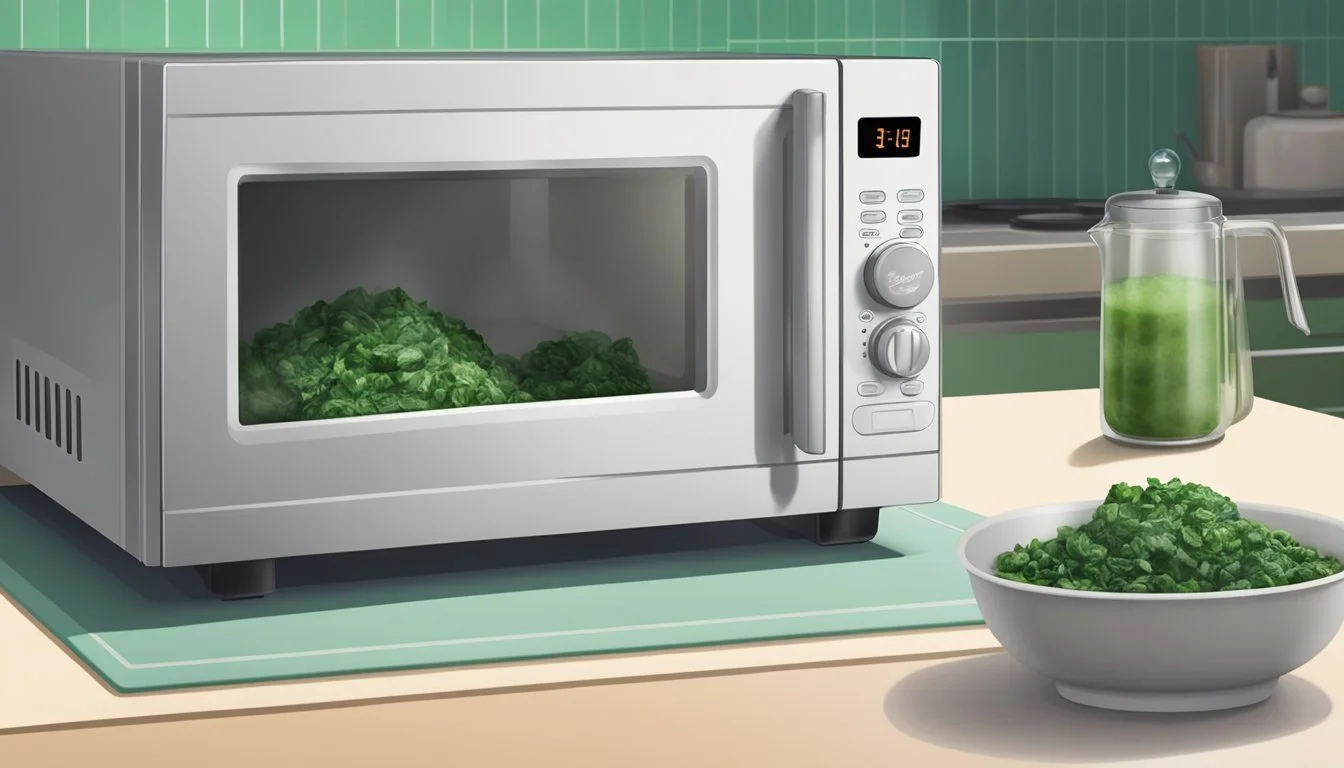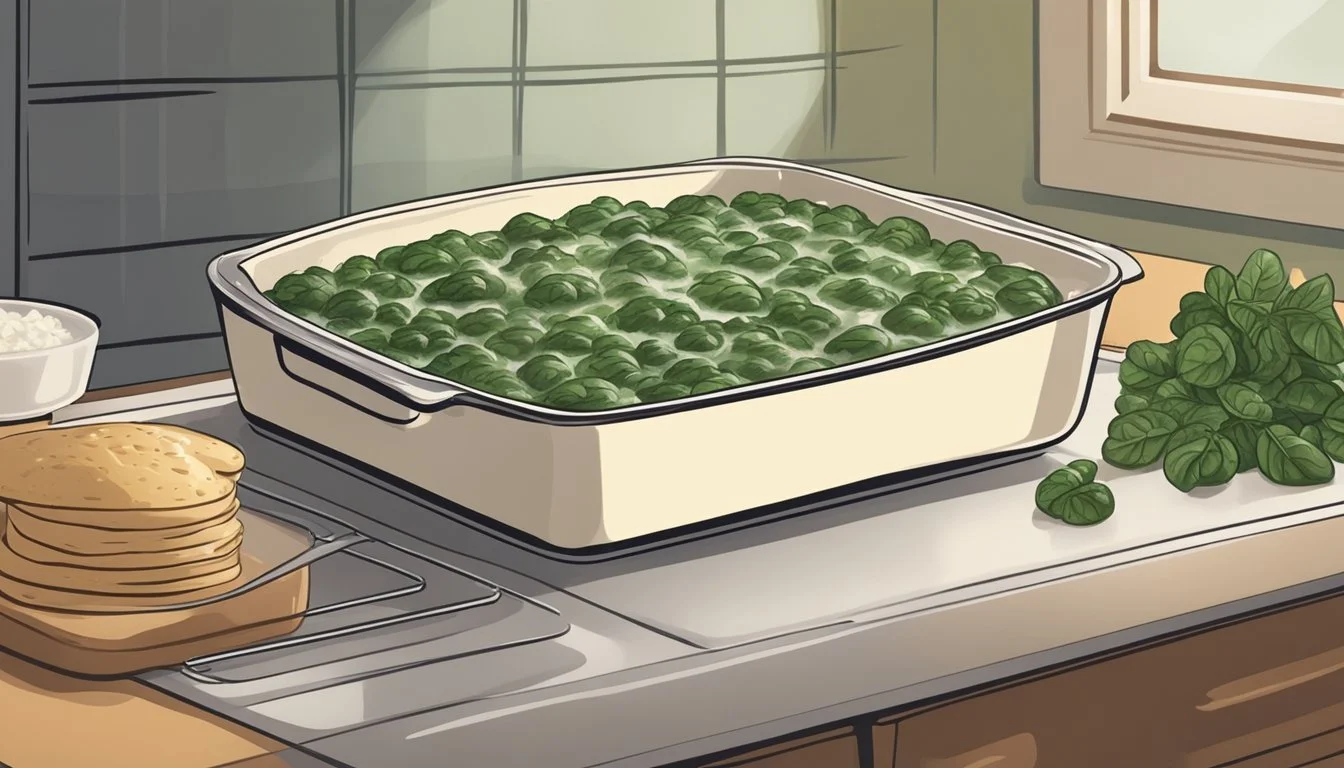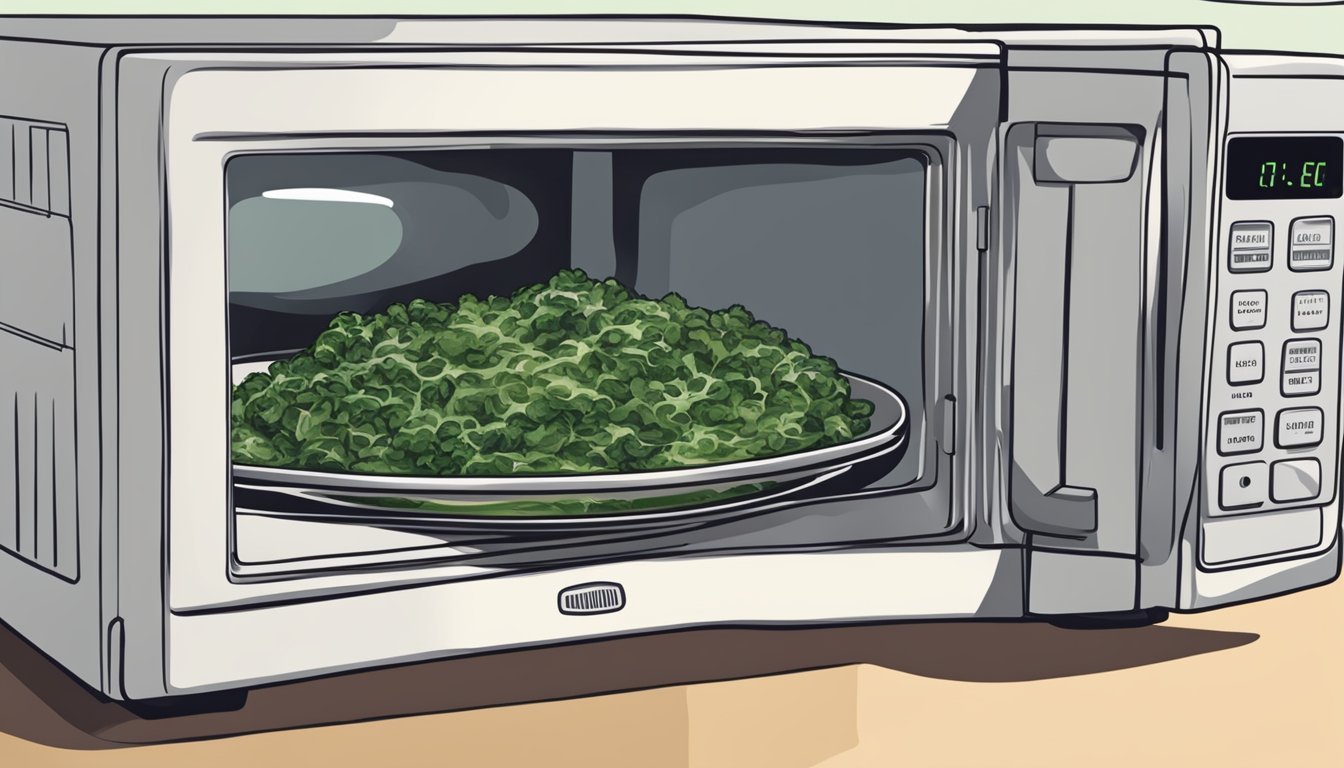How to Reheat Creamed Spinach for Optimal Flavor and Texture
Creamed spinach is a delightful side dish that can elevate any meal with its creamy texture and rich flavors. For those who find themselves with leftover creamed spinach, reheating it without compromising its taste and consistency is key. The best way to reheat creamed spinach is on the stove, where you can warm it slowly over low heat, stirring frequently.
To retain its creamy texture, add a few tablespoons of milk or cream if it appears too dry. Another effective method is using the microwave, heating it in short intervals while stirring in between to ensure even warming. For those seeking convenience, these approaches ensure your creamed spinach remains as delicious as when it was freshly made.
While stovetop and microwave methods are popular, it’s crucial to avoid overcooking, which can ruin the dish's desired consistency. Whether served as a side to a juicy steak or a part of a holiday feast, mastering the art of reheating creamed spinach will keep your leftovers savored to perfection.
Importance of Proper Reheating Techniques
Proper reheating techniques are essential to maintain the quality of creamed spinach. They help in retaining texture and moisture, preventing foodborne illness, and maximizing flavor.
Retaining Texture and Moisture
Retaining the texture and moisture of creamed spinach is crucial for an enjoyable eating experience. Creamed spinach can quickly become dry or mushy if not reheated correctly. Using methods such as reheating in the oven or stovetop allows for even heating and prevents excessive moisture loss.
Covering the dish while reheating helps to trap steam and keep the spinach moist. Using a few tablespoons of milk or cream can also help maintain a creamy consistency. Stirring occasionally ensures even heating, preserving the dish’s texture.
Preventing Foodborne Illness
Food safety is a critical aspect of reheating. Reheating creamed spinach to the right temperature ensures that any potential bacteria are destroyed. The internal temperature should reach at least 165°F (74°C) to be safe for consumption.
Avoiding rapid reheating methods like microwaving without proper precautions can help prevent uneven heating. Ensuring the dish is covered and occasionally stirred distributes heat evenly, reducing the risk of cold spots where bacteria can survive.
Maximizing Flavor
To retain the rich flavor of creamed spinach, it is important to reheat it gently. Fast reheating methods, such as microwaving on high, can cause the cream to curdle and affect the dish’s flavor profile. Methods like stovetop reheating with constant stirring can help maintain a smooth, consistent flavor.
Adding a small amount of liquid like milk or cream not only aids in moisture retention but also enhances the creamy texture and cohesive flavor. Slow, even heating brings out the spinach’s natural taste without compromising the dish.
Understanding Creamed Spinach Components
Creamed spinach is a rich and flavorful dish combining fresh or frozen spinach with various dairy products. Understanding its components can aid in preserving its taste and texture when reheating.
Key Ingredients
Spinach: Fresh spinach is often preferred for its vibrant color and texture, though frozen spinach can be a convenient and nutritious alternative. Both types provide essential vitamins and minerals.
Dairy Products: Creamed spinach typically includes butter, heavy cream, milk, and sometimes cream cheese or Parmesan. These ingredients create a velvety texture and rich flavor.
Butter adds a smooth and buttery taste, enhancing the overall creaminess.
Milk and Heavy Cream contribute to the luscious consistency, with heavy cream providing a thicker texture.
Cream Cheese and Parmesan lend additional richness and complexity to the dish, with Parmesan adding a salty, nutty flavor.
Effects of Dairy in Reheating
Dairy plays a crucial role in the reheating process. Maintaining the dish's creamy texture and preventing separation or curdling is essential.
Curdling Concerns: Higher temperatures can cause milk and cream to curdle. To avoid this, reheating should be done at a gentle temperature, typically around 300°F (150°C), and the dish should be covered to prevent moisture loss.
Adding Liquid: Incorporating a small amount of liquid, such as milk, water, or stock, during reheating helps to maintain smoothness and consistency. This is particularly useful if the spinach appears dry.
Cream Stability: Using high-fat dairy products like heavy cream can diminish the risk of curdling. Low-fat substitutes are not recommended, as they are more prone to separation.
Role of Spinach Quality
The quality of spinach significantly affects the final outcome of creamed spinach when reheated.
Fresh Spinach: Offers a more vibrant color and firmer texture. Blanching before use can preserve its bright green hue and nutritional value.
Frozen Spinach: Convenient and retains many nutrients, but may release excess moisture when thawed. Proper draining and squeezing out the water are essential to prevent a watery dish.
Texture Retention: Spinach should be gently reheated to maintain its texture. Rapid reheating can lead to a mushy consistency.
Flavor Maintenance: High-quality spinach, whether fresh or frozen, ensures that the dish retains its flavor profile. Spinach that is overly mature or improperly stored can introduce bitterness and affect the overall taste.
Pre-Reheating Considerations
Proper storage and careful defrosting are essential to maintaining the quality and safety of your creamed spinach.
Storage Tips
To ensure creamed spinach remains fresh, always store it in airtight containers. This helps prevent moisture loss and protects against contaminants. If using a refrigerator, the spinach should be kept at a consistent temperature of 40°F (4°C) or below.
Immediately refrigerate any leftover creamed spinach after cooking. It should be consumed within 3-4 days for optimal taste and safety.
For longer storage, place the spinach in freezer-safe containers. Expel as much air as possible to minimize freezer burn. Label the containers with dates to monitor freshness. Frozen creamed spinach can be kept for up to 2 months.
Defrosting Frozen Creamed Spinach
Begin by transferring the frozen creamed spinach from the freezer to the refrigerator. Let it thaw slowly for 24 hours. This gradual process helps maintain texture and prevents the cream from breaking down.
If you're in a hurry, use a microwave's defrost setting. Place the spinach in a microwave-safe container and periodically check and stir it to ensure even thawing. Avoid using hot water or leaving it out at room temperature, as this could promote bacterial growth.
After defrosting, immediately reheat and consume the spinach. Do not refreeze any leftovers to maintain quality and safety.
Reheating Creamed Spinach in the Oven
Reheating creamed spinach in the oven ensures even heating and helps maintain the dish's texture and flavor. To achieve the best results, specific steps should be followed to avoid common pitfalls such as curdling.
Oven Method Steps
Preheat the Oven: Start by preheating the oven to 300°F (150°C). This temperature is ideal for reheating without drying out the spinach.
Prepare the Spinach: Transfer the creamed spinach to an oven-safe dish. Add 1-2 tablespoons of milk, water, stock, or cream per portion to keep the mixture moist during reheating.
Cover the Dish: Tightly cover the dish with aluminum foil to trap steam and heat evenly. This prevents the spinach from drying out or burning.
Reheat: Place the covered dish on the center rack of the oven. Heat for about 15-20 minutes, or until the internal temperature reaches at least 165°F (74°C). Stir halfway through to ensure even heating.
Check and Serve: Once reheated, remove the dish from the oven, stir the spinach again, and serve immediately.
Additional Tips for Oven Reheating
Room Temperature: Let the creamed spinach sit at room temperature for 10-15 minutes before reheating to minimize thermal shock, which helps maintain a consistent texture.
Stirring: Stirring halfway through the reheating process ensures that the spinach heats evenly and prevents the top layer from drying out.
Avoid Boiling: Keep the oven temperature moderate to prevent the cream from curdling. High heat can cause separation and an undesirable texture.
Use Parchment Paper: For added protection against sticking, place a sheet of parchment paper between the spinach and the aluminum foil.
Check Moisture: If the spinach appears dry after reheating, stir in a bit more liquid before serving. This can help restore its creamy consistency.
Using the Stovetop to Reheat Creamed Spinach
The stovetop method is efficient for reheating creamed spinach while maintaining its creamy texture and flavor. This method involves gradual heating and occasional stirring to ensure consistency.
Stovetop Method Explained
Begin by transferring the cold creamed spinach to a skillet or saucepan. Place the skillet over medium-low heat to avoid overheating, which can cause the cream to curdle.
Use a spatula or wooden spoon to stir occasionally, ensuring even heating. This process usually takes about 5-10 minutes. It's essential to avoid boiling or simmering the mixture.
If the spinach appears too thick, add a tablespoon of liquid—such as milk, water, or stock—to restore the desired consistency.
Maintaining Creamed Spinach Quality on the Stove
To maintain the quality of creamed spinach, it's crucial to start heating it from a cold or room temperature state. Sudden temperature changes can negatively affect the texture.
Allow the spinach to sit at room temperature for about 10-15 minutes before reheating.
Stir the spinach periodically to prevent the cream from separating and sticking to the pan. Adding a small amount of fresh cream or butter can also help enhance the dish's flavor and richness. Be cautious with this step to avoid making the dish too greasy.
Always reheat only the amount you plan to serve to preserve the quality of leftovers for future meals.
Microwave Reheating for Speed and Convenience
Reheating creamed spinach in the microwave is quick and easy, making it ideal for busy individuals. While it's convenient, there are key techniques and common pitfalls to consider for the best outcome.
Microwave Technique Overview
Begin by placing the creamed spinach in a microwave-safe container. Cover the container with a damp paper towel to retain moisture.
Set the microwave to a medium power level to prevent overcooking. Heat the spinach for 1-2 minutes. Stir halfway through to ensure even reheating.
Check the temperature to ensure the creamed spinach is hot but not boiling. If necessary, heat in additional 30-second intervals.
Avoiding Common Microwave Mistakes
Avoid using high power settings as this can cause uneven heating and the cream to curdle. Stir the spinach halfway through to achieve even warmth throughout the dish.
Do not overcook. Overheating can result in a loss of texture and flavor. Aim to reheat just until warmed through, checking frequently to prevent overcooking.
When using a microwave, covering the container properly and reheating in small intervals helps preserve the dish's quality.
Post-Reheating Tips
After reheating creamed spinach, it's essential to ensure that it is at the right temperature. Additionally, pairing it with complementary dishes enhances the meal.
Checking for Desired Temperature
Reheated creamed spinach should reach an internal temperature of at least 165°F (74°C). This guarantees that it is safe to eat. Use a food thermometer to check this.
Insert the thermometer into the center of the dish. If using a microwave, stir the spinach halfway through reheating to avoid cold spots.
In an oven or on the stovetop, give it a good stir before checking the temperature to ensure even heating.
Pairing Creamed Spinach with Other Foods
Creamed spinach pairs well with a variety of main dishes. Steak, roasted chicken, and pasta are excellent choices.
For a balanced meal, consider serving it alongside a fresh salad or a light soup. The creamy texture of the spinach complements the richness of these main dishes.
When serving as a side dish, it can enhance the flavors of grilled fish or even a hearty vegetable stir-fry.
Serving Suggestions
Serve creamed spinach hot, topped with a sprinkle of grated Parmesan or a dash of nutmeg for added flavor.
Place it in a warmed serving dish to maintain its temperature longer. Garnish with a few toasted nuts or a drizzle of olive oil for a sophisticated touch.
Accompany the spinach with warm bread rolls or garlic bread to soak up any leftover sauce. These simple additions can elevate the meal.
Keeping these tips in mind ensures that reheated creamed spinach remains delicious and complements the rest of your meal perfectly.
Common Concerns and Troubleshooting
Reheating creamed spinach can sometimes present challenges related to overheating, separation of ingredients, and uneven heating. Below, specific strategies are discussed to address these potential issues.
Dealing with Overheating
Overheating is a common concern that can lead to the spinach becoming too hot and altering its consistency. When reheating on the stove, maintain a medium-low heat to avoid boiling or simmering, which can cause the cream to curdle.
In the oven, keep the temperature around 300°F (150°C) and monitor closely. Adding 1-2 tablespoons of liquid per portion, such as milk or stock, helps maintain moisture. Cover the dish with foil to prevent direct heat exposure. For microwaving, use short intervals of 1-2 minutes and stir in between to ensure even heating without overheating.
Addressing Separation Issues
Creamed spinach can sometimes experience separation where the cream and spinach no longer mix well. To address this, add a small amount of liquid, such as milk or cream, during reheating. Stir gently but consistently to help reincorporate the ingredients.
Room temperature spinach before reheating can reduce separation. Let the spinach sit for about 10-15 minutes outside the fridge before starting the reheating process. This step helps ensure a more consistent texture and reduces the risk of separation.
Fixing Burnt or Unevenly Reheated Spinach
Burnt or unevenly reheated spinach can ruin the dish. To avoid burning, stir the spinach regularly if using a stovetop method. Implement medium-low heat to prevent the spinach from sticking to the pan and burning.
When reheating in the oven, ensure the dish is shallow for even heat distribution. Cover it with foil to protect it from direct heat. If using a microwave, stir frequently and heat in short bursts to avoid overcooking certain areas while others remain cold.
For any reheating method, patience and frequent monitoring are key. Properly reheating and stirring can significantly improve consistency and ensure that the creamed spinach is evenly heated and ready to serve.
Conclusions on Reheating Creamed Spinach
Reheating creamed spinach can be done using several methods, each with particular steps to maintain the dish's texture and taste.
Oven Method: Preheat to 300°F (150°C). Place the spinach in a shallow baking dish, add 1-2 tablespoons of liquid (milk, water, stock, or cream). Cover with foil and heat for 5-10 minutes, stirring halfway.
Stovetop Method: Transfer the spinach to a saucepan or skillet over medium-low heat. Stir occasionally until heated through, avoiding boiling to prevent curdling. This should take about 5-10 minutes.
Microwave Method: Use a microwave-safe dish and adjust the power setting to medium. Cover with a lid or microwave-safe splatter guard to avoid spills. Reheat in short intervals, stirring in between.
Healthy Practices: Always ensure the internal temperature reaches at least 165°F (74°C) to prevent foodborne illness. Leftovers should be handled safely, returned to the refrigerator promptly after meals, and consumed within a few days.
By following these methods, one can enjoy creamed spinach that tastes as delicious as when it was first prepared.









